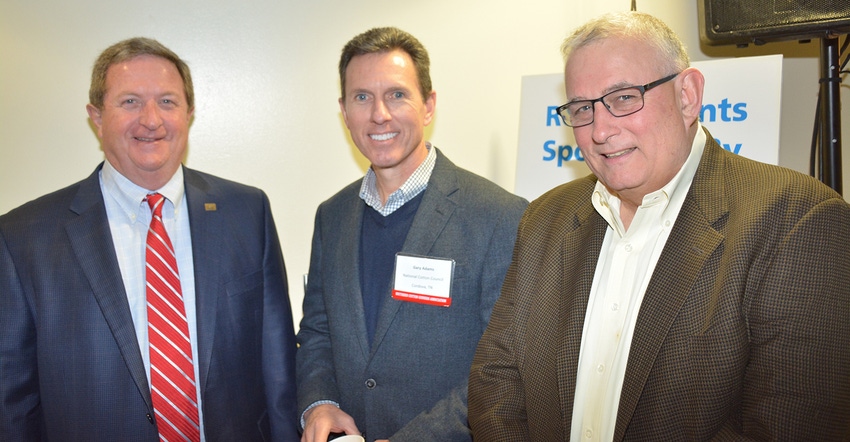March 4, 2017

USDA’s delivery of $330 million in ginning cost-share funding in record time last summer made a major difference for producers across the Cotton Belt, the chairman of the National Cotton Council said at the Mid-South Farm and Gin Show March 3.
But the NCC and its leaders are still committed to getting a cottonseed policy in place to help provide necessary support for U.S. producers — as a bridge until the new farm bill is in place, said Ronnie Lee.
“Like a lot of people in this room, we were wondering that week how we were going to make it,” said Lee, a producer and ginner from Bronwood in south Georgia who became chairman of the Council at its annual meeting last month. “We got that payment the next day, and it was really great.”
Lee traced the history of the cotton ginning cost-share program that came at a bittersweet moment for him and other leaders of the National Cotton Council who were meeting with Agriculture Secretary Tom Vilsack about this time last year.
Vilsack told then-NCC Chairman Shane Stephens, Lee and other leaders he did not have the legal authority to grant their initial request — that he designate cottonseed as an “other oilseed” that would have been eligible for Agricultural Risk Coverage or Price Loss Coverage payments under the 2014 farm bill.
Program set in motion
During the meeting, Vilsack said he believed he could provide assistance through a ginning cost-share program that was available through other authority granted to the secretary, and he set that program in motion, resulting in the payments last summer.
Payments were made on a schedule based on the cost estimates provided by the American Cotton Producers for ginning in each of the four regions of the Cotton Belt, and USDA began making payments not long after the program and payment rates were announced on June 6.
“While this stop-gap measure provided some relief to the economic pressures in the cotton industry, it did not provide the longer term, stabilizing policy the industry needs,” he said. “Thus the Council sought a legislative opportunity to advance the cottonseed proposal prior to the next farm bill’s development.
“And while we have not yet been successful in this effort, we are continuing to pursue all opportunities both in the new Congress and with the new administration.”
Unexpected pleasure
Lee said he had been coming to the Mid-South Farm and Gin Show for 21 years. “I used to stand back in that corner and, as soon as Mr. Billy Dunavant and now Joe (Nicosia) told us what they thought would happen in the cotton market, we would go outside and call our people back home and tell them what they said.
“Never did I dream that one day I would be up here speaking at this meeting.”
Lee said that the Council has been busy on a number of fronts besides trying to win approval for, in effect, making cotton a program crop, a designation it lost when Congress passed the Agricultural Act of 2014.
Among those were seeking appropriations for the cotton industry’s priorities, which along with its usual annual requests, included a special request for an increase in gin laboratory funding.
“Our efforts in the appropriations process also sought to address FDA rules that would apply new food safety regulations to cotton gins and cottonseed storage facilities,” said Lee, who besides owning a farming operation, operates a cotton ginning and warehousing company.
“In addition to our work on a farm safety net and appropriations, the Council has been very active on the international trade front, ranging from our extensive efforts on the Turkish anti-dumping case — to maintaining close communications with U.S. representatives and WTO officials to ensure they are informed on developments in cotton policies of other countries and key factors impacting the global cotton market.”
Manmade fiber excesses
He said the NCC is also conveying concerns about the detrimental impacts on global cotton demand of excess production capacity in manmade fiber markets. “By working closely with the administration and Congress, we see an opportunity for these concerns to be introduced into the WTO’s biannual ‘dedicated discussions’ on cotton.”
The Council also has been working on numerous regulatory issues, including continued close involvement on pollinator protection activities; active support for the registration of new herbicide tolerant traits; and cooperative efforts with other organizations in strong support of a national, science-based food labeling bill.
“We also have been working closely with the National Cotton Ginners Association and state/regional gin associations to address the Food and Drug Administration’s new animal food regulation that would affect certain gins and require costly assessments and controls to be put in place with respect to cottonseed,” he said.
The Council’s Cotton Flow Committee, chaired by David Blakemore, the new president of the National Cotton Ginners Association, has continued its ongoing work of monitoring Bales Made Available for Shipment data and the industry’s use of Batch 23.
“Our Quality Task Force continued its focus on contamination prevention programs. The renewed emphasis is in keeping with policy approved by the Council’s Board last year,” he said. “The task force now has oversight of a comprehensive educational program primarily aimed at producers, ginners and warehousemen.
“Contamination is a serious threat to our reputation and the premium that U.S. cotton enjoys. I cannot overstate the importance that the U.S. cotton industry do all that can be done to eliminate this threat.”
You May Also Like




